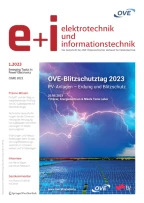Zusammenfassung
Für die thermische Absicherung elektrischer Maschinen in einer möglichst frühen Phase des Entwicklungsprozesses werden verschiedene Simulationsmethoden angewendet. Während die Wärmeleitung in den Bauteilen eindimensional berechnet werden kann, sind für den Wärmeübergang zum Innenraum der elektrischen Maschine detaillierte dreidimensionale CFD-Simulationen notwendig. Diese werden insbesondere zur Berechnung der Strömungsvorgänge im Innenraum der elektrischen Maschine genutzt. Abhängig vom Kühlkonzept der E‑Maschine handelt es sich um einphasige Luftströmungen oder eine zweiphasige Strömung bestehend aus dem verwendetem Kühlmedium und Luft.
Diese Arbeit fokussiert sich auf die einphasigen Strömungsvorgänge im Luftspalt permanenterregter Synchronmaschinen. Es wird gezeigt, wie die Strömung den Austausch zwischen Luftspalt und den beiden Stirnräumen des Elektromotors beeinflusst. Anhand detaillierter dreidimensionaler CFD-Simulationen wird die turbulente Strömung im Luftspalt und dessen Eintrittsgebiet analysiert. Dabei wird sowohl der Einfluss der genuteten Statoroberfläche auf die Taylor-Couette-Strömung im Luftspalt als auch der Einfluss der Spalteintrittströmung auf die sich ausbildende Strömungsform im Luftspalt untersucht.
Abstract
The thermal analysis of electrical machines in an early development phase is done by means of various simulation methods. The heat conduction in the solid components can, for example, be calculated one-dimensionally, whereas detailed three-dimensional CFD simulations are necessary for the heat transfer to the interior of the electrical machine. These are particularly used to calculate the flow processes inside the electrical machine. There are single-phase air flows and two-phase flows consisting of the cooling medium and the air inside. The decision on which approach has to be used depends on the cooling concept of the electrical machine.
This paper presents a numerical analysis of the single-phase flow in the narrow air gap of permanent magnet synchronous machines. It shows a flow phenomenon, which determines the interaction between the flow in the air gap and the flow in the two front spaces of the electric motor. Using detailed three-dimensional CFD simulations, the turbulent flow in the air gap and at its inlet is analyzed, examining the influence of the grooved stator surface and the flow phenomenon presented on the Taylor-Couette flow in the air gap.
Literatur
Sadr S, Abdelli A, Ben-Nachouane A, Friedrich G, Vivier S (2019) Comprehension and estimation of windage losses in rotor slotted air gaps of electrical machines using CFD-LES methods. In: IEEE Energy Conversion Congress and Exposition (ECCE), S 6078–6083
Hosain L, Fdhila BR, Rönnberg K (2017) Taylor-Couette flow and transient heat transfer inside the annulus air-gap of rotating electrical machines. Appl Energy 207:624–633
Huber A, Pfitzner M, Nguyen-Xuan T (2013) Effiziente Strömungsführung im Wassermantel elektrischer Antriebsmaschinen. ATZ Elektron 8:478–485
Taylor G (1923) Stability of a Viscous Liquid contained between Two Rotating Cylinders. Philosophical Transactions of the Royal Society, London
Vollmer U (2012) Entwurf, Auslegung und Realisierung eines verlustoptimierten elektrischen Antriebs für Hybridfahrzeuge. Dissertation. TU, Berlin
Bilgen E, Boulos R (1973) Functional dependence of torque coefficient of coaxial cylinders on gap width and Reynolds numbers. J Fluids Eng Trans ASME 95:122–126
Nachouane AB, Abdelli A, Friedrich G, Vivier S (2016) Estimation of windage losses inside very narrow air gaps of high speed electrical machines without an internal ventilation using CFD methods. XXII International Conference on Electrical Machines (ICEM), S 2704–2710
Yamada Y (1962) Torque resistance of a flow between rotating co-axial cylinders having axial flow. Bull JSME 5:634–642
Wendt F (1933) Turbulente Strömungen zwischen zwei rotierenden konaxialen Zylindern. Ingenieur Arch 4:577–595
Nakabayashi K, Yamada Y, Kishimoto T (1982) Viscous frictional torque in the flow between two concentric rotating rough cylinders. J Fluid Mech 119:409–422
Kümmel W (2007) Technische Strömungsmechanik, 3. Aufl. Teubner, , S 57–61
Beck C, Keller D, Echtle H, Haug S, Krüger C, Bargende M (2019) Sensitivitätsanalyse der Wärmequellensowie Wärmetransportmodellierung in permanenterregten Synchronmaschinen. Elektrotech Informationstech 136(2):195–201
Ferziger JH, Perić M (2008) Numerische Strömungsmechanik. Springer, Berlin Heidelberg
Nicoud F, Ducros F (1999) Subgrid-scale stress modelling based on the square of the velocity gradient tensor. Flow Turbulent Combust 62(3):183–200
Andereck D, Liu S, Swinney HL (1986) Flow regimes in a circular Couette system with independently rotating cylinders. J Fluid Mech 164:155–183
Poncet S, Viazzo S, Oguic R (2014) Large eddy simulations of Taylor-Couette-Poiseuille flows in a narrow-gap system. Phys Fluids 26:105108
Author information
Authors and Affiliations
Corresponding author
Appendix
Appendix
Rights and permissions
About this article
Cite this article
Meier, V., Beck, C., Krüger, C. et al. Numerische Analyse der Strömung am Eintritt des Luftspalts einer permanenterregten Synchronmaschine. Elektrotech. Inftech. 139, 222–229 (2022). https://doi.org/10.1007/s00502-022-01001-8
Received:
Accepted:
Published:
Issue Date:
DOI: https://doi.org/10.1007/s00502-022-01001-8
